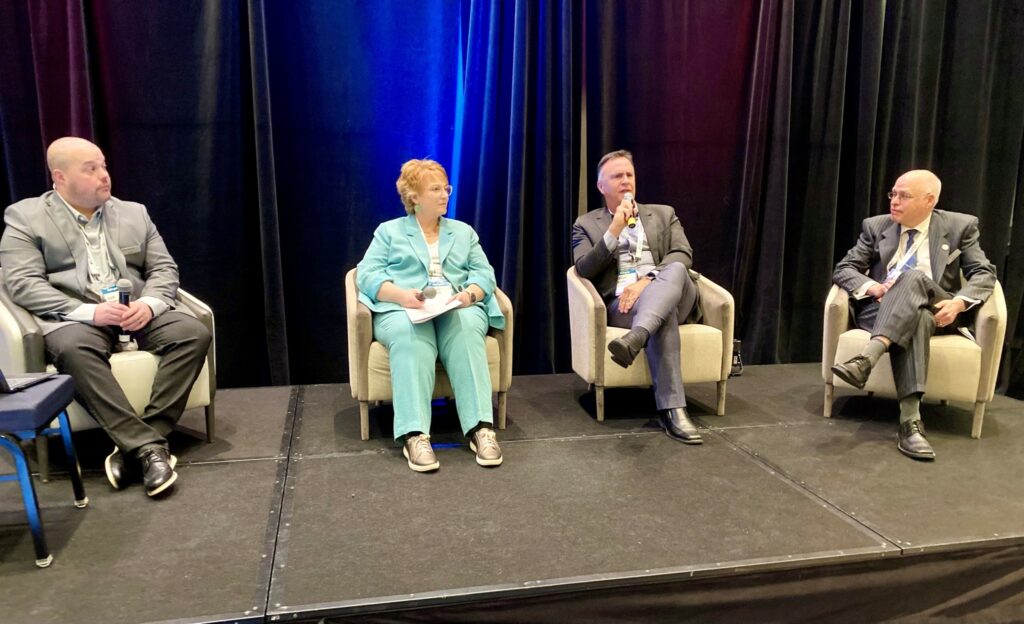The biggest barrier to interprovincial trade is the lack of, and the need to improve, existing infrastructure, leaders of three western provincial trucking associations said.
British Columbia is spending half a billion dollars to address slow-moving landslides that affect highways, Dave Earle, president of the B.C. Trucking Association (BCTA), told attendees at the Alberta Motor Transport Association’s (AMTA) annual conference in Edmonton on April 9. Moving heavy and oversized loads is a challenge within the province, let alone transporting freight to other provinces.
He added that “stupefying” amounts of money were being used to fix roads, not expand them.

The Saskatchewan government has not invested in technology to improve roads, and the province does not do a great job paving them, Susan Ewart, executive director of the Saskatchewan Trucking Association (STA) said during a fireside chat at the conference. She added that a lot of secondary highways need maintenance.
Bemoaning the lack of infrastructure, AMTA president Robert Harper noted that customers were routing overweight and over-dimensional freight from Houston, Texas, rather than Vancouver.
“It sometimes takes 3 days to move an 11-hour shipment because of regulations in B.C.,” he said, adding that permitting needs to be harmonized. He urged governments to “facilitate moving goods and not just slap regulations and say figure it out.”
Leadership needed to make decisions
Illustrating the sorry situation, Earle said 23 municipalities in B.C.’s Lower Mainland cannot agree on a definition of a truck. Saying that this “lunacy is ridiculous,” he called for leadership to make decisions.
Ewart said that that government institutions sometimes can’t make decisions and impede progress. She added that in Saskatchewan the Ministry of Highways and SGI (Saskatchewan Government Insurance) engage in finger pointing on simple things and get hung up on issues.
Tariffs
The threat of U.S. tariffs and the pauses on their implementation have added a layer of uncertainty to the industry, as carriers await the fallout and wonder in which direction to pivot. The outlook is pessimistic but there could be opportunities as well.
Ewart said Saskatchewan carriers are not looking to buy equipment. The province’s economy is export-based, and tariffs could hit businesses. She added that people are not being laid off now, but costs will be passed on to customers.
Earle noted that the softwood lumber is teetering on the brink of extinction due to duties and forest fires. Cancelled voyages for ships to ports in B.C. are also up which could affect drayage. He predicted that it would be rough year, but there would be opportunities to carve out success as people still need stuff and trucking companies help bring that stuff to them.
Driver Inc.
AMTA’s Harper said that Driver Inc. model of doing business is compounding the pressure tariffs are bringing on the industry. In this model, companies misclassify drivers as independent contractors by requiring them to incorporate, potentially avoiding obligations under labor laws and taxes.
Citing the example of trucks hitting overpasses in B.C., Earle said a culture has evolved to lie and cheat. He called it a “pervasive rot” that is causing overpasses to be hit, new Canadians exploited and people avoiding paying taxes.
The BCTA is taking the fight to the shippers, educating them on their responsibility to measure loads and ensure paperwork is in order before the freight leaves on a truck.
Ewart said the STA has stopped calling it Driver Inc. and chooses to address it as fraud in trucking. She added that there is not enough oversight to ensure that ethical carriers can survive and thrive.
Harper blamed the federal tax system for turning a blind eye to this issue. “This is a hydra-type monster. You can chop off a head, but eventually, you have to kill the monster,” he said.